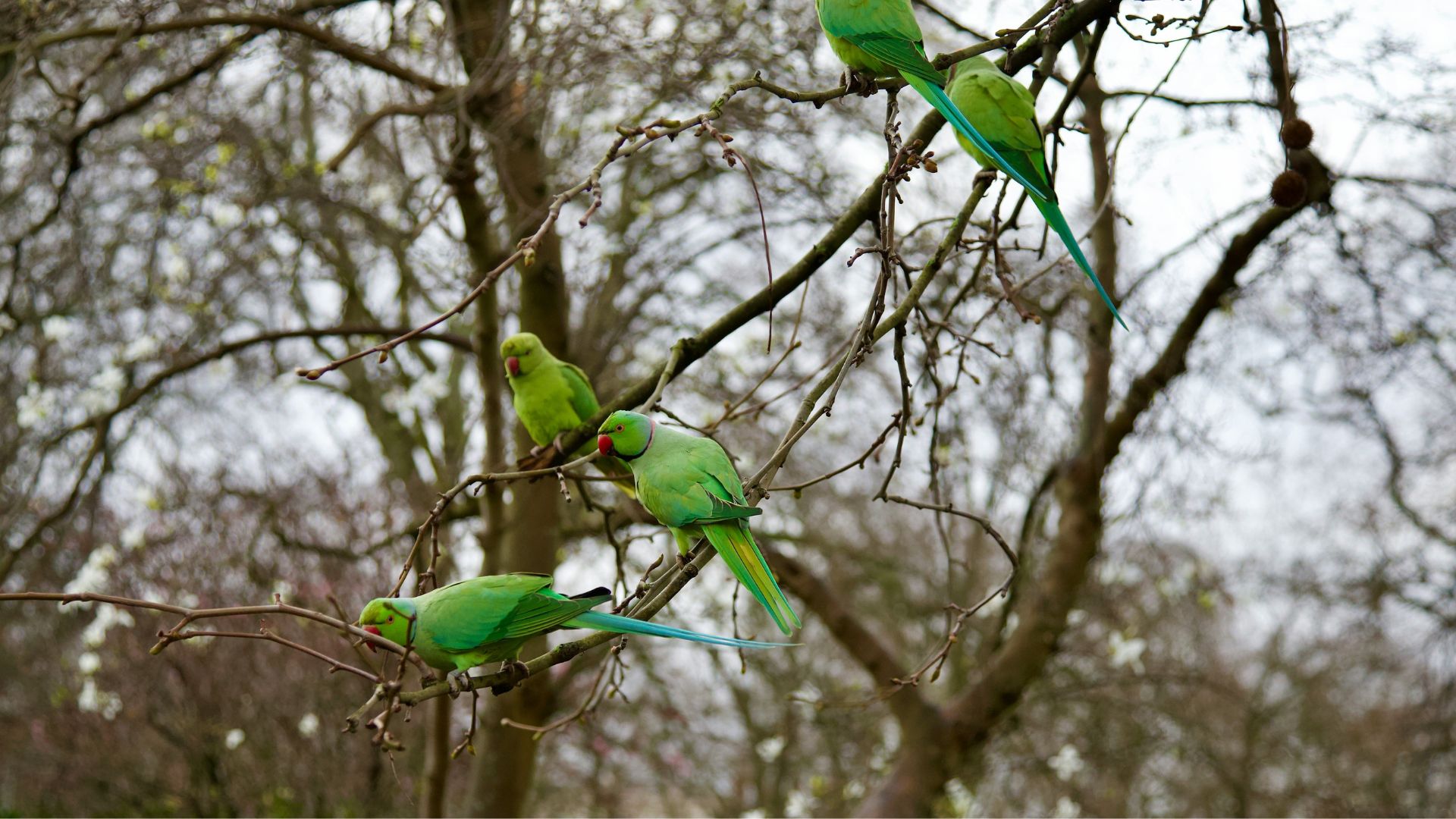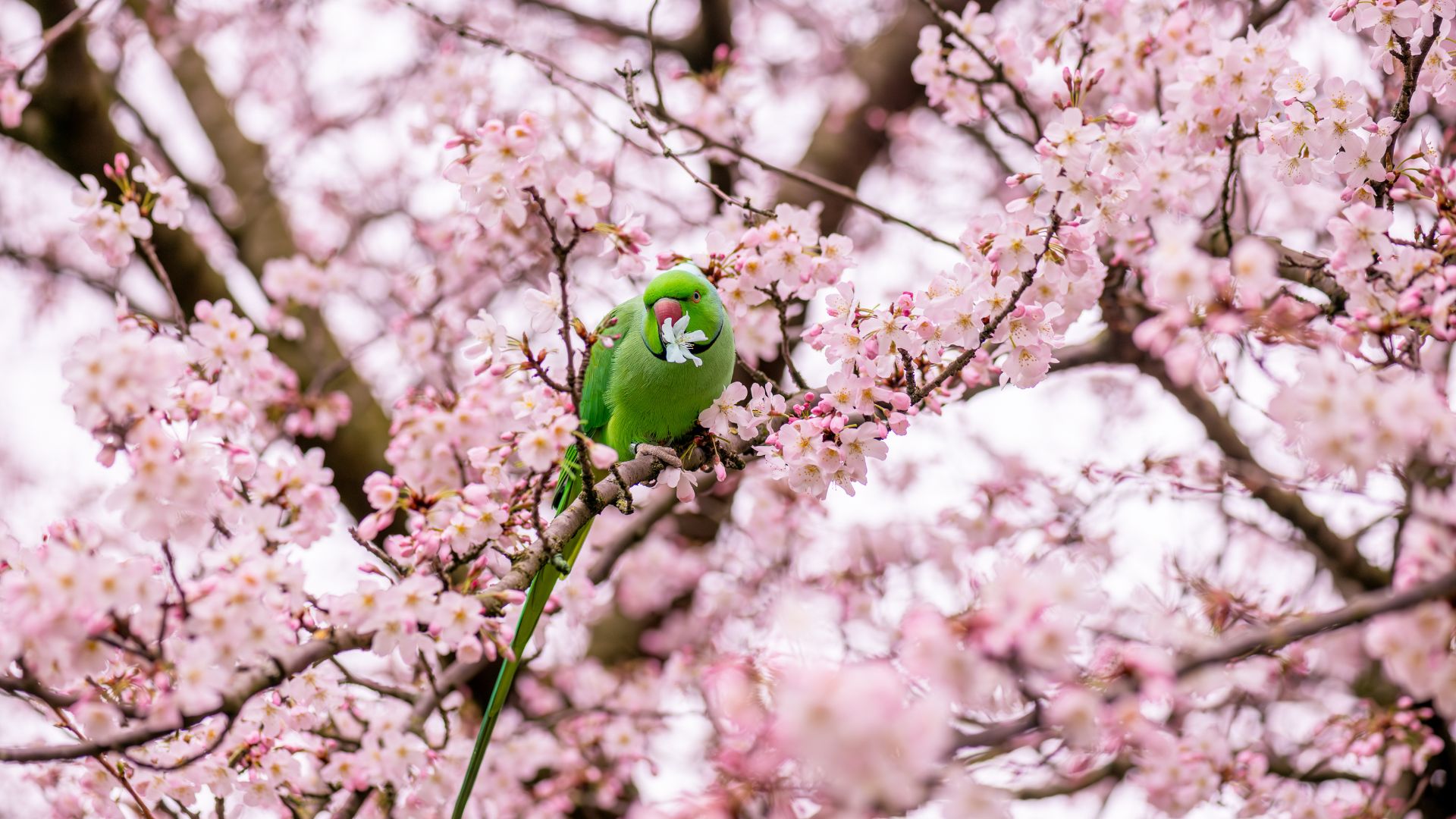You’ve probably spotted vibrant green streaks zipping through London’s skies or lounging in some of the city’s most iconic parks and wondered – how did parrots end up here?
These ring-necked parakeets, Britain’s only naturalised parrot, have been thriving in the capital since the late '90s, sparking wild theories about their arrival, including one involving the likes of Jimi Hendrix and Carnaby Street.
From urban legends to leafy hangouts, we’re diving into the full parrot story: where they came from, where to find them and whether these tropical Londoners are here to stay.
Why are there parakeets in London?
While tales of their arrival are as colourful as the birds themselves, records of wild parakeets in the UK go back to the mid-1800s. But it wasn’t until the late 1990s that these noisy newcomers began appearing in large numbers across London and the southeast – turning from rare sightings into everyday park regulars.

Once confined to leafy southern spots like Kew and Richmond Park, they’ve since spread across the capital and into the Home Counties. By 2021, their population had soared to around 50,000 in London alone.
As the climate warms, ring-necked parakeets – along with other heat-loving species – are increasingly settling into Britain’s milder urban areas. Naturally, their rise has sparked a flurry of myths, the most popular being that a pair of these colourful characters were released into the wild to kickstart their city-wide takeover.
So, who released the parakeets into the UK?
No London phenomenon is complete without a few wild origin stories. From escaped pets to tales of music legends setting them free, the parakeet takeover has inspired its fair share of myths.
The Jimi Hendrix theory – Legend has it that Jimi Hendrix released a breeding pair during a 1960s Carnaby Street stunt. It’s a colourful tale, though many doubt it ever happened.
The African Queen theory – Some say the birds escaped from the set of The African Queen, filmed at Isleworth Studios in 1951. But large flocks weren’t spotted in the area until decades later.
The Great Storm of 1987 – The storm reportedly destroyed aviaries in Surrey, allowing pet parakeets to escape. Sightings followed soon after, though the evidence remains anecdotal.
George Michael vs Boy George – One theory blames a burglary at George Michael’s home, another claims a dramatic fallout with Boy George. Either way, both stories point to pop royalty as being behind the parakeet plot.
Parrot Fever – Scientists suggest fears over psittacosis, or “Parrot Fever,” led owners to release their birds in large numbers. With enough of them out in the wild, the parakeets were able to thrive and multiply.
But what’s the real story? According to researchers at Queen Mary University of London, none of these urban myths are true. Most ornithologists agree that the parakeet population is the result of repeated releases and introductions over time, not a singular dramatic event.
While scientists can’t pinpoint exactly when or where it all began, it’s clear that Londoners have kept parakeets as pets for centuries and some were bound to escape. With enough birds out in the wild, it was only a matter of time before they became a permanent fixture in the city’s skyline.
Where can you find parakeets in London?

London’s wild parakeets can be spotted across the capital, with large flocks often seen in Kensington Gardens, Richmond Park, Kew Gardens, Hyde Park and Brockwell Park.
For an up-close encounter, head to Kensington Gardens near the Peter Pan statue – these birds are so used to interacting with humans they’ll happily take nuts or seeds straight from your hand.
If you’re planning to feed them, stick to bird-friendly snacks like seeds and nuts and skip the bread – it’s not great for their health. For a more natural display, stick around until dusk when the parakeets return in lively, chattering groups that fill the trees with colour and sound.
How do parakeets survive in London?
Parakeets survive in London surprisingly well. Being highly intelligent and adaptable birds, they’ve learned to adjust their feeding habits to suit their surroundings, thriving not just in the UK but across parts of Europe and North America.
Although London’s urban setting doesn’t seem like the most inviting place for a tropical bird, its wide selection of parks, gardens, mature trees, hedgerows and older buildings offers a habitat very similar to the fragmented forests of their native range. These adaptable birds nest in tree hollows and thrive on fruit, flowers, young buds and seeds, using their strong beaks to crack them open.
At around 40 centimetres long, including their long tail feathers, ring-necked parakeets are bold, competitive and built for survival. In their native habitats, they scramble with other parrots for space and food – and it’s that same feisty nature that has some conservationists concerned about their impact on local wildlife, which has been forced to adapt to these bright green newcomers.
Are parakeets in London considered pests?

Their loud squawks, especially during flight or at communal roosts, are one reason some people label parakeets as “pests”. While they tend to stay quiet around nesting sites to avoid predators, their vocal nature can be hard to ignore.
Technically, they’re classified as agricultural and horticultural pests by Natural England, but they’re also legally protected as wild birds and widely adored for their tropical flair in London’s green spaces.
As for their impact, it’s still unclear what effect, if any, they’re having on native species or the wider environment so a control programme is unlikely. With their numbers steadily rising, ring-necked parakeets have become, and are very likely to remain, a vibrant fixture in the city – and for many Londoners, they’re now a celebrated part of the capital’s identity.

